Native Son – November, 2011
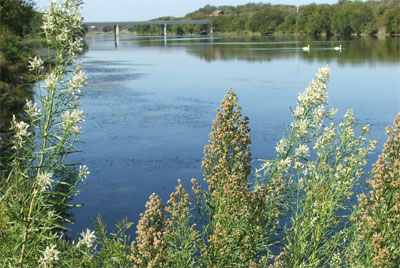
Swans sail across the river in Pedernales River Nature Park on the outskirts of Johnson City. All photos by Steven Chamblee.
Road Trip to Canyon Lake/Bastrop
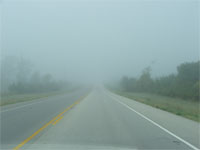
The author starts his road trip on this foggy road.
My ears soak up Crosby, Stills, and Nash as I head off into heavy fog for a road trip down to Canyon Lake, Texas. As I’m crossing the Brazos River just south of Tin Top, a small sign on the bridge notes, “John Graves Scenic Riverway.” I’ve never really met John Graves, though I heard him speak at one of the BRIT [Botanical Research Institute of Texas] lectures a few years ago. Among other things, he spoke of ecological messes, conservation successes, and of how this water was once called “Rio de los Brazos de Dios,” which translates to “River of the Arms of God.” Perhaps one day I will embark on a canoe journey such as he did…. If I don’t, I’ll have to settle for Goodbye to a River, a book published in 1960 based upon his thoughts while canoeing the Brazos before the Lake Granbury dam was built.
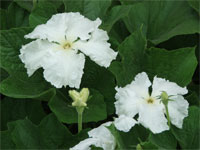
Giant exotic blossoms of Indian gourd in Hico.
Mile after mile, my eyes feast upon the treasures found along the road … bright yellow Maximilian sunflowers, red and orange fall color on the sumacs, exotic Indian gourd blossoms at a small motel, and a great sign, “Hico, Texas … Where Everybody Is Somebody.” My first wildflower emergency stop comes just north of Adamsville, where I find blackfoot daisy and antelope horns near a harvester ant mound. I’m just old enough to remember finding loads of hornytoads (technically, “horned lizards”) in the fields near my childhood home on the west side of Fort Worth. They heartily gulped up the big red ants, which we thought was really cool, ‘cause it served them mean old ants right. Little did we realize then the fragile connection between the two species, and as soon as people killed off the red ants, so went the hornytoads.

Ball moss in the trees along the Pedernales River.
I pull into Pedernales River Nature Park on the northern outskirts of Johnson City, and the tiny road takes me by what seems like a zillion parking/camping places before I finally see the river. At this moment, I’m the only person out here, though I figure this must be a popular hangout on weekends. Down at the river’s edge, a thin band of non-mown vegetation hints at the ecology found up and down the banks of the Pedernales: goldenrod, aster, rattlebush, false indigo, and the fluffy white blossoms of Roosevelt weed. Ball moss hangs from live oak, bois d’arc, and cedar elm branches. A pair of swans grace the water, joined occasionally by a passing great blue heron and a small hawk. An energetic kingfisher holds my attention for a few moments until the rumble of a semi on the bridge across the way brings me back to the here and now. (“So much water moving underneath the bridge … may the water come and carry us away….”)
Soon enough, I’m at the Hwy 46 intersection and hang a left toward Canyon Lake. I just love the little roads of the Texas Hill Country, winding relentlessly up, down and through the live oaks. My speaking engagement is at 6 p.m., and it’s now … wow, just 4 p.m. I am stunned at my own commitment to personal responsibility. (Reading this, my father just fell out of his chair.) The evening passes in a flash, thanks to some fine Texas hospitality and a “brother from another mother” who wise-cracked with me to the point I thought both of us were going to get booted from the meeting.
The next morning, I head out on a mission of significance. Like everyone else, I heard about the Bastrop fires, but I want to see some of it myself. I want to witness this important time in Texas history — a time when drought and fire and economy have honed our decisions and shaped our character. The charm of the small roads quickly dispels my stoic mood, and soon I find myself on “Old Bastrop Highway,” which I figure is a good way to get there. After a while, the road dead-ends into another, the signs disappear, and I’m floating down a blue-lane, heading, as Arlo Guthrie said, “…past houses, farms, and fields….” One minute, I’m taking pictures of a killer cactus ensnarled in a barbed-wire fence, the next I’m talking to an Aggie’s mom about her horticulture major son. An old cotton field smiles at me and I visit for a few minutes. The road soon narrows to a slim ribbon and hangs a 90 onto a one-lane bridge. Holy Toledo, Batman, it’s time to pull over.

Mighty buttressed trunks of bald cypress along a river.
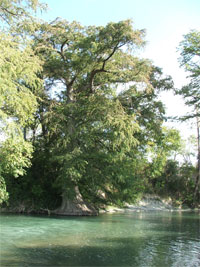
Mature bald cypress growth form.
Before me sit, at water’s edge, huge bald cypress trees. Huge. Bald cypress trees (Taxodium distichum) have a native range from Virginia south to Florida and west to Texas. Most of The Lone Star State’s bald cypress trees are in East Texas, particularly in wetlands, swamps, and lakes such as Caddo Lake. As you move westward, the native range of these trees is restricted to waterways where a constant source of water is provided. Young trees have a perfect pyramid shape to their growth habit, but as they mature, this shape gives way to a more rounded canopy and the development of massive buttressed trunks … like these trees. Tangles of roots eventually become enveloped within the buttresses, forming phantasmal natural sculptures. Interestingly, these trees do not display any of the “knees” that are characteristic of bald cypresses growing in saturated soils … which leads me to wonder, are they Montezuma cypress (T. mucronatum), a species native much farther south along the Rio Grande, or a possible hybrid? I decide not to be a worry-wart about the details and simply enjoy them for their majestic beauty.
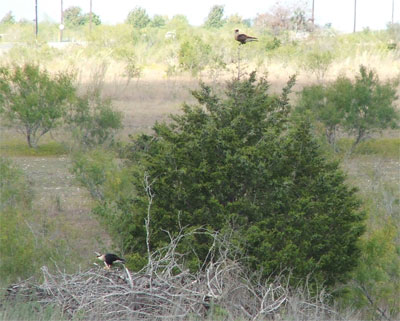
A pair of caracaras pause for a moment near Bastrop.
A few miles later and I’m visiting a concrete sculpture place, sitting on the tailgate and swapping stories with the owner amid piles of aging birdbaths, funny bunnies, smiling turtles, and Cupie doll-faced angels. Although his place was not burned in the fires, sadness weighs heavily on his shoulders. Those burned out were his neighbors, friends, countrymen. While we talk of hardships and history, a pair of caracaras alight in a distant tree, adding a mysterious element to the tableau.
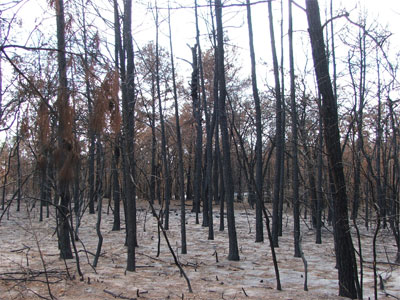
Fire-ravaged pine forest in Bastrop.
The main entrance to the Bastrop State Park is closed, so I take a nearby road northward. I am not sure what to expect … my imagination has conjured up images of me standing on a ridge overlooking a black landscape, with nothing standing higher than my knee. The reality is different … there is no ridge from which to survey the scene, and the trees are all still standing. As you drive down the road, the fire damage is different every few hundred yards. Sometimes the trees are burned only halfway up; sometimes they are completely burned. Some sections of the forest are brown; others black as coal. The fire had to be massive, for it jumped right over the four-lane divided highway and kept going. I take a side road so I can slow down and process the scene before me. From what I can tell, this section of forest is, or was, a mix of pine and oak, and both have burned completely. The forest floor is completely clean — no debris at all, not even a charred pinecone lying around. Across the road, a red fire hydrant stands helplessly in front of a charred forest.
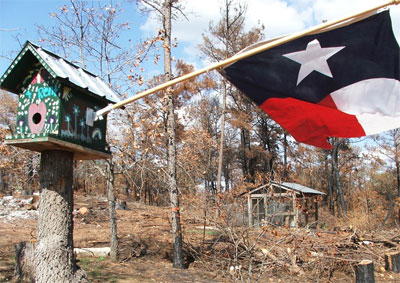
The Texas flag waves proudly over the remnants of a homestead.

Dishes still fill a kitchen sink.
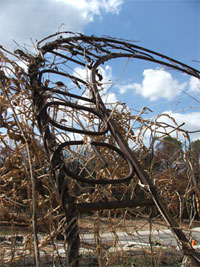
This "God Bless This Garden" arch still stands after the inferno.
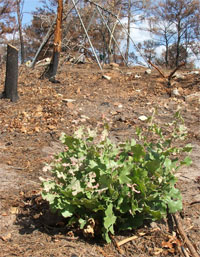
Oak trees re-sprout from the base near a swingset.
An old steel arch catches my eye, and I am drawn to it. This was someone’s garden. Furrows scratched into the earth indicate the vegetable patch. Tiny stubs are all that is left of shrubs and small trees. It is only now that I realize there was a house not far away. Only stone, brick, ceramic, and steel remain. I surmise the burned trees that surrounded the house were cut down after the fire … why else would I see pine cones in the living room? The kitchen sink rests over there, still full of dishes. An old claw-foot bathtub sits a few feet away. A small plastic box holds small garden relics that survived the fire…. Someone collected them up after the blaze and then decided to leave them here. Fifty feet away, the wooden chicken coop still stands, as does a decorative birdhouse. Flying proudly from the birdhouse is a new Texas flag. It speaks the words I cannot muster. I walk by the arch again, and notice the words upon it: “God Bless This Garden.” I try to be positive and think that whole “from the ashes we shall rise” thing, but it’s hard to think of rebuilding when so much has been destroyed so quickly. I turn around to take a parting photo … and only now do I see the oak tree has already re-sprouted from the base. A silly little laugh of joy and surprise passes from my lips, but it doesn’t seem like it came from me. I look around…. ALL of the oaks have re-sprouted! Little foot-tall, multi-trunk trees dot the burned landscape all around me. Hmmm, I’ll bet there are pine seeds in the dirt, too. I guess Mother Nature is not giving up either. She has a plan, and she’s already working on it.
About the author: Steven Chamblee is the chief horticulturist for Chandor Gardens in Weatherford and a regular contributor to Neil Sperry’s GARDENS magazine and e-gardens newsletter. Steven adds these notes:
Fall into the holidays ay Chandor Gardens! The Encore azaleas are flowering, the trees are turning golden yellow, and the squirrels are going nuts! Don’t miss our big Holiday Open House event on Saturday, Dec. 10, 9 a.m. to 3 p.m. We’ll have live music, lots of holiday decorations, and festivities galore … and it’s all FREE! Just take I-20 west to exit 409, hang a right, go 2.1 miles and hang a left on Lee Avenue. Head straight 12 blocks and you’re driving in the gates. Call 817-361-1700 for more information. You can always go to www.chandorgardens.com for a picture tour and details.
I can always use another road trip! Let me know if you’d like me to come out and speak to your group sometime. I’m low-maintenance, flexible, and you know I like to go just about anywhere. No city too big; no town to small. Just send me an e-mail at schamblee@weatherfordtx.gov and we’ll work something out.

